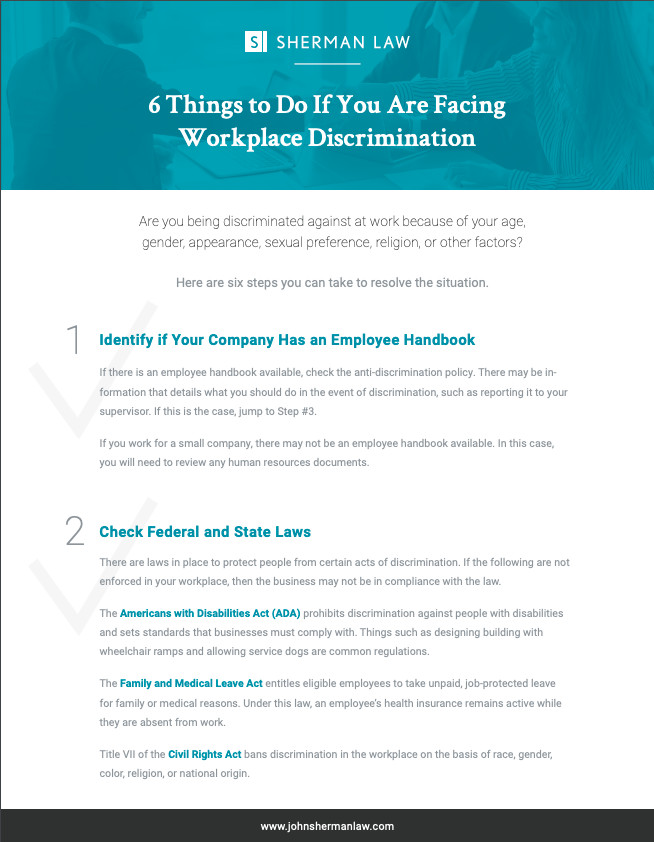What is Age Discrimination in the Workplace? [Examples & FAQs]
In 1967, the Age Discrimination in Employment Act (ADEA) was created to protect people from discrimination and harassment in the workplace. While this was a very positive step toward protecting workers’ rights, age discrimination and harassment still occur in every industry and sector today.
In a survey conducted by AARP, two out of three workers aged 45 and older said they had seen or experienced age discrimination at work. AARP also found that there are significant differences between the genders when it comes to age discrimination. In the same age group as the previous survey, 72% of women said they think people face age discrimination at work while only 57% of men agreed.
Equally troubling is the idea of what is considered “old” among employees, especially for employers in Silicon Valley and similar tech-centered locations where age discrimination appears magnified. In the tech world, most employees are in their late 20s and workers over the age of 35 often have a hard time landing a job due to their “old” age.
Read on to learn the specifics of age discrimination in the workplace, as well as signs that you may be experiencing discrimination.

How to Act Against Workplace Discrimination
There are certains steps you need to take to resolve your situation. Download a free checklist for a 6-step guide.
Download NowAge Discrimination Laws
The ADEA prohibits age discrimination against people who are 40 years or older and applies to:
- Companies with at least 20 employees
- Labor organizations with at least 25 members
- Employment agencies
- Federal, local, and state governments
Independent contractors and military personnel are not protected under the ADEA. The law also does not protect people under the age of 40. However, some states have their own laws to protect younger people from discrimination.
Age-based harassment is illegal when it is frequent or severe enough to create a hostile work environment, or if it leads to the victim being fired or demoted. It is also unlawful throughout every phase of employment, including:
- Job Postings
- Job descriptions
- Interviews
- Hiring
- Salaries
- Job assignments
- Merit increases
- Performance management and evaluation
- Training
- Disciplinary actions
- Promotions
- Demotions
- Benefits
- Employment termination
- Layoffs
10 Signs of Age Discrimination at Work
If you are concerned that you may be experiencing age discrimination in the workplace, you may be right. Here are 10 signs that your employer may be illegally discriminating against you because of your age.
1. Hearing Age-Related Comments or Insults
Employers or managers who make age-related remarks or speak to you in a demeaning tone may be hovering on the line of harassment. While not quite there yet, their behavior can signal a larger issue.
As reported by Time, “Even those oldest boomers not held back professionally because of age may experience something called micro-aggressions, which are ‘brief and commonplace daily verbal, behavioral, and environmental indignities, whether intentional or unintentional, that communicate hostile, derogatory or negative slights and insults to the target person or group.’” This is according to research out of Columbia University.
2. Seeing a Pattern of Hiring Only Younger Employees
As previously mentioned, there is a pattern in Silicon Valley and the technology industry. The EEOC reports that older workers in technology roles experience significantly high rates of age discrimination, with 70% of IT staffers claiming to have witnessed or experienced it first-hand. In addition, 40% of older technology workers consider their age to be a liability to their career.
Below are the average ages for popular tech companies as reported by Smart Insights:
| Company | Average Age |
| AOL | 27 |
| 28 | |
| 29 | |
| Salesforce | 29 |
| 30 | |
| Apple | 31 |
| Amazon | 31 |
| Yahoo | 31 |
| eBay | 32 |
| Adobe | 33 |
| Microsoft | 33 |
| Dell | 36 |
| IBM | 38 |
| Oracle | 39 |
| HP | 39 |
Silicon Valley is not the only area where younger employees are hired over older employees. The Bureau of Labor Statistics reports the following median ages for a selection of industries:
| Industry | Median Age |
| Hospitality | 31 |
| Wholesale & Retail | 39 |
| Construction | 42 |
| Professional & Business Services | 42 |
| Education | 43 |
| Financial | 44 |
| Manufacturing | 44 |
| Transportation & Utilities | 45 |
If you notice an age-related hiring pattern at your company, you could be on to something. Many employers will never say it, but they may be specifically looking for younger workers. This is often due to unfounded misconceptions about ability, work pace, knowledge, and sociability.
An employer’s use of the term “overqualified” may be a sign of age discrimination. It is unlawful for an employer not to hire an experienced older person based solely on the assumption that they might become bored or dissatisfied and leave the job.
3. Getting Turned Down For a Promotion

If you have been turned down for a promotion that ended up going to a younger worker who was less qualified, you may have evidence of age discrimination. If you can show a pattern of older workers being overlooked for promotions that typically go to younger workers with no evidence of the decisions being based on merit, your case for age discrimination will gain a lot of clout.
What can you do if you have faced age discrimination? Get a free case assessment to learn your options.
4. Being Overlooked for Challenging Work Assignments
One way employers may attempt to force older employees out is by “lightening the load,” or removing challenging work and projects from their plate. This tactic frustrates and demoralizes the worker while making them look less useful and valuable to the broader organization. This perpetuates the myth that older workers are not as knowledgeable and are less capable.
5. Becoming Isolated or Left Out
Similar to the previous point, employers or managers may begin to remove you from meetings, leave you out of decisions, and may even isolate your desk location away from your department or group, thereby making it more difficult for you to contribute and be a valuable part of the team.
Going a step further, they may ask you to work from home or relocate you to a different office altogether — possibly even to another state or location that would cause a major disruption in your life.
6. Being Encouraged or Forced to Retire
Oftentimes companies will offer early retirement packages to older employees as an incentive to push them out. These packages are typically hard to turn down for employees. Even if an employee turns down a retirement package and the option to retire, there is no saying that the company will not go ahead and fire them anyway.
Similarly, although illegal today, some companies try to enact a mandatory retirement age. However, enforcing a mandatory retirement age is only legal in a limited number of specific professions, such as law enforcement and firefighting.
7. Experiencing Layoffs
Layoffs happen at companies of all shapes and sizes. But if your company is only laying off older employees, you may be able to prove age discrimination. Because layoffs require legalities, companies are typically smart enough to dilute layoff groups by including a sampling of younger employees in the mix as well.
8. Having Your Position Eliminated
This is an all-too-common practice at companies throughout the country: eliminating a role by changing the job title. If an employer says that your job is being eliminated but then hires a younger employee to work in the same capacity as you only with a different title, this is possible evidence of age discrimination.
9. Receiving a Performance Improvement Plan
Being put on a performance improvement plan is never a good sign. If you have had strong reviews in the past and have no history of poor performance, being suddenly put on an improvement plan is a strong sign that your employer is looking for a “legal” way to fire you.
10. Facing Unfair Discipline
All employees should be treated equally. If you seem to receive harsher criticism or discipline than your co-workers for similar issues or mistakes, this can be a subtle yet sure sign of age discrimination.
How Common is Age Discrimination at Work?
Most age discrimination goes unreported, making it difficult to measure its prevalence in the workplace.
However, in 2018 the Equal Employment Opportunity Commission (EEOC) resolved 90,558 charges of discrimination and secured $505 million for victims of discrimination in private, state and local government, and federal workplaces. This included more than 554,000 phone calls and emails related to potential discrimination claims.
How Employers Can Help Prevent Age Discrimination
Establish a Policy
Employers should clearly define acts of age discrimination and create instructions on how company leaders should address instances. Make sure all employees are aware of this policy.
Rethink Your Interview Processes
There are certain questions that should be avoided during interviews with potential employees. Asking a candidate their age, when they plan to marry, if they want children, or when they hope to retire should not be part of your interview questions.
Review Existing Policies & Procedures
Indirect age discrimination can also occur in the workplace. It is beneficial to examine any areas where there are biases, such as in recruitment practices, sick leave policies, or training processes.
Enforce Non-Discriminatory Practices
For employers, layoffs can bring concerns about the proper and legal ways to let employees go. In many instances, eliminating an entire department can avoid any appearances of age discrimination, but this is not always the best-case scenario. In any situation, it is imperative to hire an employment law attorney to ensure that your company is in compliance with the law.
Age Discrimination Frequently Asked Questions
Q: Who does the Age Discrimination in Employment Act (ADEA) protect?
A: The ADEA protects certain job applications and workers who are at least 40 years old from discrimination based on age in hiring, promotion, termination, compensation, and terms of employment.
The ADEA only protects employees who work for:
- Companies with at least 20 employees
- Labor organizations with at least 25 members
- Employment agencies
- Federal, local, and state governments
Q: Can an employer ask my age during a job interview?
Q: Is age discrimination common?
Q: How can I prove age discrimination?
A: You will need evidence of harassment, unfair discipline, exclusion, or favoritism that has affected you in a negative way. It is important to document any instance of discrimination and to record any witnesses to your experience.
Proving age discrimination can be very challenging, which is why it is important to consult with an employment law attorney.
Q: Can age discrimination occur during the interview process?
Q: What are examples of age discrimination at work?
Q: What can I do if I have been discriminated against because of my age?
Q: How long do I have to file an age discrimination claim?
A: You should act very quickly after facing age discrimination in the workplace. The type of situation that took place and the type of business you work for will determine the time you have to file a claim.
In many instances, you have as little as 180 days from the last date of discrimination. You should consult with an employment law attorney to find the exact time limit for your unique situation.
Q: As an employer, how can I prevent age discrimination?
How You Can Move Forward

Not only is age discrimination wrong but the reasons employers practice it are based on unfounded assumptions. In fact, Inc. reports that there are often more benefits to hiring older workers than drawbacks.
If are facing workplace discrimination due to your age, race, sex, ethnicity, religion, disability, or sexual orientation, you have rights. There are federal and state laws that prohibit discriminatory acts, which can support your case.
At Sherman Law, we have been protecting workers rights for more than 25 years. If you feel that you are facing any type of discrimination in the workplace, it is important that you retain experienced employment counsel to help you navigate the law and stand up for your rights. Contact us today for a free consultation.

